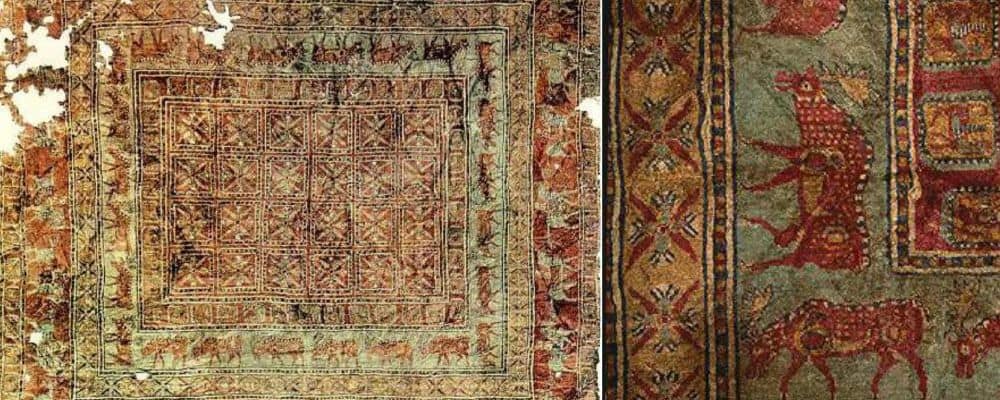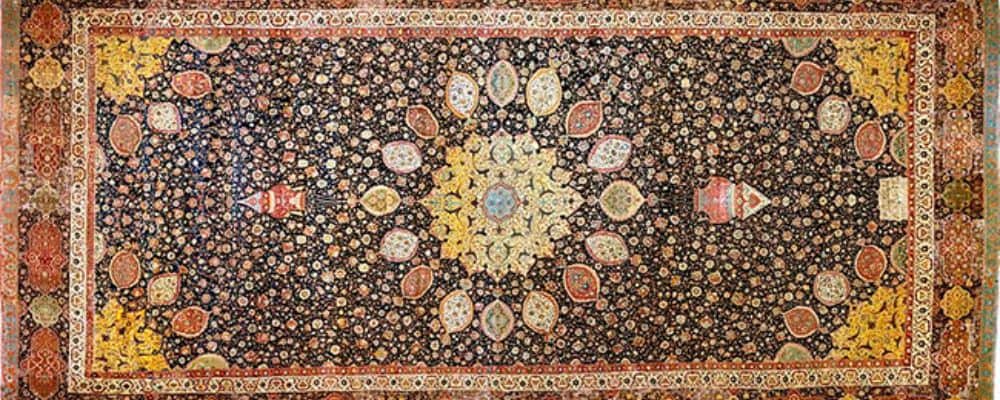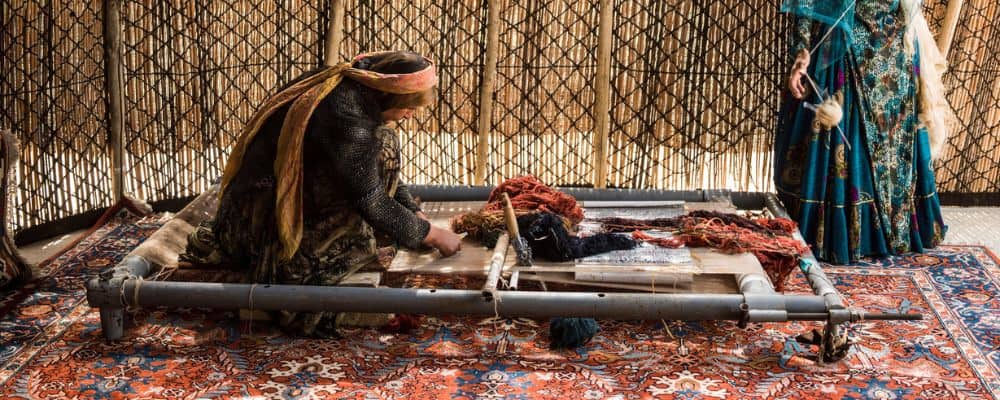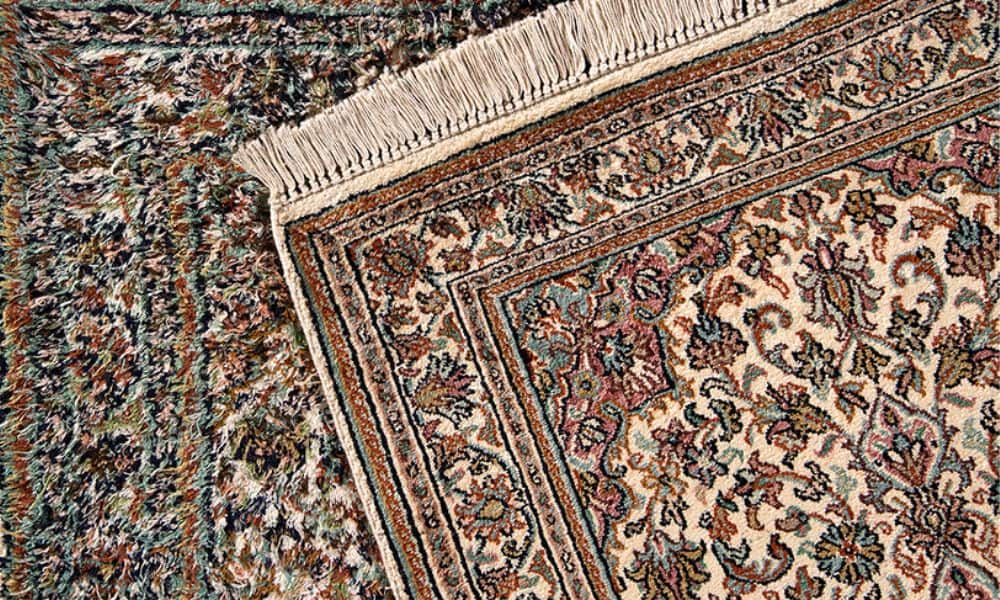Step into a world interlaced with strands of tradition and invention as we explore the history of rugs and carpets.
What is a Rug?
A rug or carpet is a cloth floor with a top layer attached at the back. A rug may also refer to any decorative textile made of a thick material. Until the nineteenth century, carpet referred to any covering, including tablecloths and wall hangings. However, since the development of machine-made items, rugs have primarily been employed as floor coverings.
Piles are frequently made up of distorted tufts that have been heat-treated to maintain their structure. “Carpet” or “Rug” are used internationally to describe these mounds. Carpet and rug are often used interchangeably. To put it more clearly, literary carpets are floor coverings that aren’t directly affixed to the ground.

Origin of Rugs and Carpets
People have created carpets out of every available material. Ancient cultures weaved reeds and grass together to create primitive carpets that kept the chilly ground warm.
According to excavations, the earliest hand-tied eastern carpet found today originated in Iran and is roughly the same. 2,500 years old. The rug density exceeded 300,000 knots per square meter, matching the knot density of most recent handmade carpets. Hand-knitted rugs are thought to have begun with wandering tribes people who transformed wool into the first flat woven cloth 500 years before Christ.
When discussing the history of rugs and carpets, several topics must be addressed ahead of time. Rugs were woven from camel, sheep, and goat hair by nomadic tribes 5,000 years ago. Archaeologists discovered carpets dating back over 4,000 years in Egyptian and Mesopotamian graves.
Evolution in History of Rugs and Carpets
In terms of the history of rugs and carpets, millennia ago, it was customary for tribal people to make carpets out of weeds and long grass to create the oldest carpets, which are merely the primary framework for keeping the soil warm on cold days.
The ancient rugs were made 5000 years ago by nomadic nomads using animal skins. Travellers make camel, sheep, and goat wool carpets by hand-knitting them. In addition, dynamic carpets were used in traditional gardens. Archaeologists’ comprehensive research has proven that rugs were common in Egypt and Mesopotamia as early as 4,000 years ago.
However, different places of the world have contributed to evolution in various ways.

12th century
Rug manufacturers in India date back to the 12th century. From then, it took shape and moved eastward. Rug making became popular in Sri Lanka throughout time. A few crusaders travelling to the Middle East later brought the rugs to Europe.
13th century
In the 13th century, Arabs in southern Spain pioneered the production of hand-knotted rugs throughout Europe. This skill eventually extended to France, where various factories were built to function.
14th to 15th Century
During the 14th and 15th centuries in Persia, it evolved into a business structure. The craftsmen who created these Persian rugs were inspired by life in Persia, the richness of their culture and tradition, which is reflected in the majority of these rugs. These rugs were exceptionally durable and were passed down through the family as a treasure for generations. Rug patterns and hues evolved in Isfahan, Persia, which eventually became the rug industry’s hub.
16th century
Persian and Turkish rugs first arrived in Europe at this time. France’s rug manufacturing began in 1628. It was located in Chaillot. From here, the French weavers learned the skill of weaving. This was the period when themes and vibrant colors were a part of the rug. Tapestries were in full bloom at Aubusson, a tiny town in France. These were produced by hand, with wool as the primary raw material, to ensure the highest quality.
17th-18th centuries
England gradually became the hub of Europe’s rug-making business. It expanded even more with the introduction of power looms in 1780. Initially, wool was the only raw material used in rug production due to its strength, fiber length, and durability. Silk was introduced later, around the 18th century. Silk carpets, which have an incredibly soft feel, were used as meditation mats.
19th century
Flat-woven rugs were popular among the masses due to their low cost. Hand-knotted rugs were not something that many segments of society could buy for their homes. As demand for hand-knotted carpets increased, so did production, as more people sought to adorn their floors with them. People were persuaded by the vibrant colors and complex textures. With these hand-knotted and oriental rugs, there was an increase in demand for English and Italian furniture to complement home interiors.
20th century
Machine-made rugs became increasingly popular to meet consumer demands. These rugs featured identical patterns that were virtually monochromatic in color. With its simplicity in color and pattern, home decorators may easily mix the rug into any type of room. The intricate patterns and intricacies of the designs were not particularly popular.
As a result, the majority of people will find it simple and straightforward. The most popular colours at the time were beige and aubergine. The reason for this is that these colors complement any type of room setting, making interior design even easier.
Furthermore, in the 1950s, tufting guns were introduced. It became more popular than handwoven rugs at the time. The United States became the center for tufting carpets, and from there it expanded its reach to other parts of the world.
- Anime Rugs
- Modern Rugs
- Cartoon Rugs
- Outdoor Rugs
21st century
Rug creation has evolved to include various colors, patterns, designs, styles, materials, and weaving techniques. This suits the aesthetic preferences of a variety of customers. Every day, the rug-making process evolves to match the type of style individuals want for their homes.
Rugs are now considered a worthwhile investment. People’s knowledge of rugs has steadily increased. From the sourcing of raw materials to the cleaning tricks that ensure the treasured rug lasts for years.
Modern carpets come in a variety of forms and sizes to suit any area, from a basic living room to a large hotel lobby. There are rugs that can match your child’s artistic abilities and even offer a neutral vibe to an otherwise lively area.
The good news is that handmade rugs bring a sense of sustainability to your life. With these carpets, you move a step closer to creating a better environment, which is desperately needed. Furthermore, carpets are available in a variety of price ranges to fit your budget, so going sustainable is no longer prohibitively expensive.
Production History of Rugs and Carpets
The Pazyryk Carpet, which dates from 500 BC, is the oldest carpet still in existence today. It was found in 1949 in Siberia. Despite its age, the carpet was a monument to highly advanced and complex technology with rich color fibers, provided they had expert carpet cleaners to preserve Pazyryk carpets sharp.

It is not unexpected that the history of rugs and carpets dates back as far as man. People have a natural desire to seek comfort and harmony. Man has always sought to create a comfortable environment. Nature remains unchanged, regardless of whether we are talking about cave people or modern people. Men who live in caves have been shown to keep warm on chilly days by covering themselves with carpets, rugs, and animal hair.
They were historically fashioned of wool, but since the twentieth century, synthetic fibers such as polypropylene, nylon, or polyester have grown more affordable, thus they are now commonly used. However, significant divergence occurred throughout the history of rugs. Let us clearly discuss them in the context of rug evolution.
Conclusion
Finally, the evolution and history of rugs and carpets provide a fascinating glimpse into time, culture, and craftsmanship. Rugs and carpets have played an important role in human history, starting as functional floor coverings and progressing to wonderful works of art. The elaborate designs, brilliant colors, and intricate weaving processes, which span millennia and continents, reflect not only the creators’ creativity and ingenuity, but also the stories and customs of other nations. As we continue to value and protect these cultural treasures, we honor the legacy of previous generations while also celebrating the timeless beauty and continuing legacy of rugs and carpets in the modern world.
We at Custom rugs will give our everything to make your custom rug emit that vibe and personality which you desire for.
Contact us at +8613613866590 now to get professional guidance in finding perfect rugs for your spaces and get 10% OFF on your first order.

